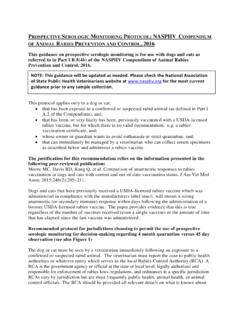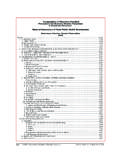Transcription of Public Veterinary Medicine: Public Health
1 JAVMA Vol 248 No. 5 March 1, 2016 505 Rabies is a fatal viral zoonosis and serious Public Health All mammals are believed to be susceptible to the disease, and for the purposes of this document, use of the term animal refers to mam-mals. The disease is an acute, progressive encephali-tis caused by viruses in the genus Rabies virus is the most important lyssavirus globally. In the United states , multiple rabies virus variants are main-tained in wild mammalian reservoir populations such as raccoons, skunks, foxes, and bats. Although the Unit-ed states has been declared free from transmission of canine rabies virus variants, there is always a risk of reintroduction of these 7 The rabies virus is usually transmitted from ani-mal to animal through bites. The incubation period is highly variable. In domestic animals, it is generally 3 to 12 weeks, but can range from several days to months, rarely exceeding 6 Rabies is communicable during the period of salivary shedding of rabies virus.
2 Experimental and historic evidence documents that dogs, cats, and ferrets shed the virus for a few days prior to the onset of clinical signs and during illness. Clinical signs of rabies are variable and include inap-Compendium of Animal Rabies Prevention and Control, 2016 National Association of State Public Health Veterinarians Compendium of Animal Rabies Prevention and Control Committee Catherine M. Brown dvm, msc, mph (Co-Chair) Sally Slavinski dvm, mph (Co-Chair) Paul Ettestad dvm, ms Tom J. Sidwa dvm, mph Faye E. Sorhage vmd, mphFrom the Massachusetts Department of Public Health , 305 South St, Jamaica Plain, MA 02130 (Brown); the New York City Department of Health and Mental Hygiene, 2 Gotham Center, CN# 22A, 42-09 28th St, Queens, NY 11101 (Slavinski); the New Mexico Department of Health , 1190 St Francis Dr, Room N-1350, Santa Fe, NM 87502 (Ettestad); and the Texas Department of State Health Services, PO Box 149347, MC 1956, Austin, TX 78714 (Sidwa).
3 Consultants to the Committee: Jesse Blanton, PhD (CDC, 1600 Clifton Rd, Mailstop G-33, Atlanta, GA 30333); Richard B. Chipman, MS, MBA (USDA APHIS Wildlife Services, 59 Chenell Dr, Ste 2, Concord, NH 03301); Rolan D. Davis, MS (Kansas State University, Room 1016 Research Park, Manhattan, KS 66506); Cathleen A. Hanlon, VMD, PhD (Retired); Jamie McAloon Lampman (McKamey Animal Center, 4500 N Access Rd, Chattanooga, TN 37415 [representing the National Animal Care and Control Association]); Joanne L. Maki, DVM, PhD (Merial a Sanofi Co, 115 Trans Tech Dr, Athens, GA 30601 [representing the Animal Health Institute]); Michael C. Moore, DVM, MPH (Kansas State University, Room 1016 Research Park, Manhattan, KS 66506); Jim Powell, MS (Wisconsin State Laboratory of Hygiene, 465 Henry Mall, Madison, WI 53706 [representing the Association of Public Health Laboratories]); Charles E. Rupprecht, VMD, PhD (Wistar Institute of Anatomy and Biology, 3601 Spruce St, Philadelphia, PA 19104); Geetha B.
4 Srinivas, DVM, PhD (USDA Center for Veterinary Biologics, 1920 Dayton Ave, Ames, IA 50010); Nick Striegel, DVM, MPH (Colorado Department of Agriculture, 305 Interlocken Pkwy, Broomfield, CO 80021); and Burton W. Wilcke Jr, PhD (University of Vermont, 302 Rowell Building, Burlington, VT 05405 [representing the American Public Health Association]).Endorsed by the AVMA, American Public Health Association, Association of Public Health Laboratories, Council of State and Territorial Epidemiologists, and National Animal Care and Control article has not undergone peer correspondence to Dr. Brown dysphagia, cranial nerve deficits, abnormal behavior, ataxia, paralysis, altered vocalization, and seizures. Progression to death is rapid. There are cur-rently no known effective rabies antiviral recommendations in this compendium serve as a basis for animal rabies prevention and control pro-grams throughout the United states and facilitate stan-dardization of procedures among jurisdictions, there-by contributing to an effective national rabies control program.
5 The compendium is reviewed and revised as necessary, with the most current version replacing all previous versions. These recommendations do not supersede state and local laws or requirements. Prin-ciples of rabies prevention and control are detailed in Part I, and recommendations for parenteral vaccina-tion procedures are presented in Part II. All animal ra-bies vaccines licensed by the USDA and marketed in the United states are listed and described in Appendix 1, and contact information for manufacturers of these vaccines is provided in Appendix of note in this updated version of the compendium, compared with the previous ver-sion,9 include clarification of language, explicit en- Public Veterinary Medicine: Public Health506 JAVMA Vol 248 No. 5 March 1, 2016couragement of an interdisciplinary approach to ra-bies control, a recommendation to collect and report at the national level additional data elements on rabid domestic animals, changes to the recommended man-agement of dogs and cats exposed to rabies that are ei-ther unvaccinated or overdue for booster vaccination, reduction of the recommended 6-month quarantine period for certain species, and updates to the list of marketed animal rabies I.
6 Rabies Prevention and ControlA. Principles of rabies prevention and control1. Case definition. An animal is determined to be rabid after diagnosis by a qualified laboratory as specified (see Part I. A. 10. Rabies diagnosis). The national case definition for animal rabies requires laboratory confirmation on the basis of either a positive result for the direct fluorescent antibody test (preferably performed on CNS tissue) or isola-tion of rabies virus in cell culture or a laboratory Rabies virus exposure. Rabies is transmitted when the virus is introduced into bite wounds, into open cuts in skin, or onto mucous membranes from saliva or other potentially infectious material such as neural Questions regarding pos-sible exposures should be directed promptly to state or local Public Health Interdisciplinary approach. Clear and con-sistent communication and coordination among relevant animal and human Health partners across and within all jurisdictions (including interna-tional, national, state, and local) is necessary to most effectively prevent and control rabies.
7 As is the case for the prevention of many zoonotic and emerging infections, rabies prevention requires the cooperation of animal control, law enforce-ment, and natural resource personnel; veterinar-ians; diagnosticians; Public Health professionals; physicians; animal and pet owners; and others. An integrated program must include provisions to promptly respond to situations; humanely re-strain, capture, and euthanize animals; administer quarantine, confinement, and observation periods; and prepare samples for submission to a testing Awareness and education. Essential compo-nents of rabies prevention and control include ongoing Public education, responsible pet owner-ship, routine Veterinary care and vaccination, and professional continuing education. Most animal and human exposures to rabies can be prevented by raising awareness concerning rabies transmis-sion routes, the importance of avoiding contact with wildlife, and the need for appropriate vet-erinary care.
8 Prompt recognition and reporting of possible exposures to medical and Veterinary professionals and local Public Health authorities are human rabies prevention. Rabies in humans can be prevented by eliminating exposures to rabid animals or by providing exposed persons prompt postexposure prophylaxis consisting of local treatment of wounds in combination with appropriate administration of human rabies im-mune globulin and vaccine. An exposure assess-ment should occur before rabies postexposure prophylaxis is initiated and should include dis-cussion between medical providers and Public Health officials. The rationale for recommending preexposure prophylaxis and details of both pre-exposure and postexposure prophylaxis adminis-tration can be found in the current recommenda-tions of the Advisory Committee on Immunization ,12 These recommendations, along with information concerning the current local and re-gional epidemiology of animal rabies and the availability of human rabies biologics, are avail-able from state Health Domestic animal vaccination.
9 Multiple vac-cines are licensed for use in domestic animal spe-cies. Vaccines available include inactivated and modified-live virus vectored products, products for IM and SC administration, products with dura-tions of immunity for periods of 1 to 3 years, and products with various minimum ages of vaccina-tion. Recommended vaccination procedures are specified in Part II of this compendium; animal ra-bies vaccines licensed by the USDA and marketed in the United states are specified in Appendix 1. Local governments should initiate and maintain effective programs to ensure vaccination of all dogs, cats, and ferrets and to remove stray and un-wanted animals. Such procedures have reduced lab-oratory-confirmed cases of rabies among dogs in the United states from 6,949 cases in 1947 to 89 cases in Because more rabies cases are re-ported annually involving cats (247 in 2013) than dogs, vaccination of cats should be Ani-mal shelters and animal control authorities should establish policies to ensure that adopted animals are vaccinated against important tool to optimize Public and ani-mal Health and enhance domestic animal rabies control is routine or emergency implementation of low-cost or free clinics for rabies vaccination.
10 To facilitate implementation, jurisdictions should work with Veterinary medical licensing boards, Veterinary associations, the local Veterinary com-munity, animal control officials, and animal wel-fare Rabies in vaccinated animals. Rabies is rare in vaccinated 15 If rabies is suspected in a vaccinated animal, it should be reported to pub-lic Health officials, the vaccine manufacturer, and the USDA APHIS Center for Veterinary Biologics JAVMA Vol 248 No. 5 March 1, 2016 507( ; search for adverse event reporting ). The laboratory diagnosis should be confirmed and the virus variant characterized by the CDC s rabies reference laboratory. A thorough epidemiologic investigation including documen-tation of the animal s vaccination history and po-tential rabies exposures should be Rabies in wildlife. It is difficult to control rabies among wildlife reservoir Vacci-nation of free-ranging wildlife or point infection control is useful in some situations,17 but the suc-cess of such procedures depends on the circum-stances surrounding each rabies outbreak (See Part I.)






